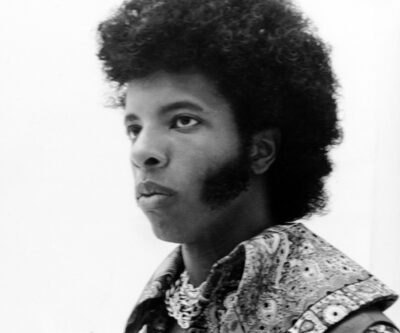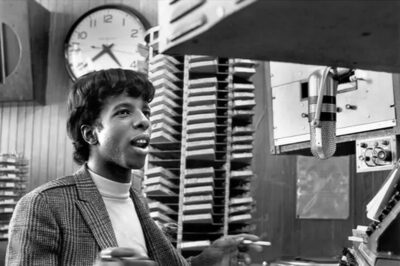Sly Stone Was the Architect of Funk and the Voice of a Generation Introduction: The Genius Who Changed Music Forever Sylvester Stewart, bett
Sly Stone Was the Architect of Funk and the Voice of a Generation
Introduction: The Genius Who Changed Music Forever
Sylvester Stewart, better known as Sly Stone, was more than just a musician—he was a revolutionary force who changed the landscape of funk, soul, and rock. From his innovative production techniques to his socially conscious lyrics, Sly Stone’s influence has reverberated through generations of artists. His band, Sly & the Family Stone, didn’t just produce music—they created a movement.
This is the story of how Sly Stone rose to prominence, how his music shaped the culture of the 1960s and 1970s, and how his legacy remains alive today, despite the struggles that marked his later years.
Sly Stone, born Sylvester Stewart, was the second of five children in a deeply religious family. His parents, K.C. and Alpha Stewart, were devoted members of the Church of God in Christ (COGIC), which encouraged musical expression. This religious upbringing played a significant role in shaping his early musical influences.
Sylvester Stewart was born in Texas in 1943. Growing up in Vallejo, California, Sly and his siblings—Freddie, Rose, and Vaetta Stewart—were immersed in gospel music. They formed a family gospel group called The Stewart Four, recording their first single, On the Battlefield for My Lord, in 1952. This early exposure to harmonies and spiritual music laid the foundation for Sly’s later fusion of gospel, soul, and funk.
After moving to California, Sly expanded his musical horizons, learning to play multiple instruments and immersing himself in the Bay Area’s vibrant music scene. His influences ranged from gospel and blues to the emerging sounds of rock and R&B. As a radio DJ, he had access to a wide variety of music, which helped shape his eclectic approach to production and songwriting.
His brother Freddie became the guitarist for Sly & the Family Stone, while his sister Rose was a vocalist and keyboardist in the band. Their integrated, multi-gender lineup was groundbreaking, reflecting both their musical upbringing and Sly’s vision for unity through music.
Sly Stone’s family played a huge role in shaping his songwriting and performance style. Growing up in a musically gifted household, he was surrounded by gospel harmonies and rhythm, which later influenced his approach to funk and soul.
Sly’s ability to blend gospel, rock, soul, and funk was deeply rooted in his family’s musical background. His vision for unity through music was not just a personal philosophy—it was a reflection of his upbringing.
From DJ Booth to Funk Prophet: Sly Stone’s San Francisco Radio Roots
Before the world knew him as Sly Stone, the funk maestro was simply Sylvester Stewart, a brilliant young mind reshaping the soundscape of Bay Area radio. His broadcast journey began at KSOL (1450 AM), a soul/R&B station in San Francisco, where he worked as an on-air DJ in the early 1960s.
But Sly wasn’t your average disc jockey. He had a curatorial genius—seamlessly blending gospel, doo-wop, jazz, rock, and soul, sometimes talking over intros, injecting sly humor, and mixing records live in ways that defied convention. His sets became freeform experiences, often politically aware, musically fearless, and always electric.
By the mid-1960s, Sly was working as a disc jockey at KDIA, a prominent soul and R&B radio station in San Francisco. Known on-air as “Sylvester Stewart”, he quickly gained a reputation for his charisma, deep musical knowledge, and eclectic taste. His radio shows weren’t just playlists—they were sonic adventures. He was a musical alchemist, blending gospel, doo-wop, soul, jazz, and psychedelic rock into his sets. He didn’t just spin records—he curated sonic experiences, often talking over intros, mixing genres, and injecting humor and commentary. This fearless experimentation became the blueprint for the genre-defying sound of his band.
This radio playground became his creative launching pad. His radio work also sharpened his production instincts. While at KSOL, he was simultaneously producing for Autumn Records, where he helped craft hits like Bobby Freeman’s “C’mon and Swim” in 1964, and later, working with acts like The Beau Brummels and Grace Slick’s early band, The Great Society. This dual role—DJ by day, producer by night—gave him a rare, 360-degree view of the music industry, allowing him to understand both what moved listeners and how to craft it in the studio.
These tracks were among the first major hits to emerge from the San Francisco music scene, marking an early success in his production career. Laugh, Laugh was released in December 1964 and reached #15 on the Billboard Hot 100, while Just a Little followed in 1965, peaking at #8.
These songs showcased Stone’s ability to craft tight, melodic arrangements with a mix of folk rock and British Invasion influences, foreshadowing his later genre-blending innovations. His work with the Beau Brummels helped establish Autumn Records as a key player in the mid-’60s pop scene. His production work helped shape the San Francisco sound, influencing artists beyond his own band.
In short, Sly’s time in radio didn’t just influence his music—it ignited a revolution. The DJ booth was his first stage, and from there, he built a sound that would change the world.
Sly Stone’s transition from DJ and producer to fronting Sly & the Family Stone was a natural evolution of his musical vision. In 1966, he merged his band, Sly and the Stoners, with his brother Freddie’s band, Freddie and the Stone Souls, forming a groundbreaking group that featured a racially integrated and mixed-gender lineup—a rarity at the time.
The band quickly gained attention for their electrifying live performances, particularly during their residency at Winchester Cathedral, a club in Redwood City, California. Their unique blend of funk, rock, soul, and psychedelic music set them apart from other acts in the Bay Area.
Ascension: Signing with Epic Records
In 1967, Sly & the Family Stone caught the attention of Epic Records, a division of CBS Records, which was looking to expand its roster with innovative artists. Their signing was largely due to their high-energy performances and Sly’s reputation as a visionary producer. Epic Records released their debut album, A Whole New Thing, later that year, marking the beginning of their legendary career.
Dance to the Music: The Breakthrough That Changed Everything
After the commercial underperformance of their debut album A Whole New Thing in 1967, Sly & the Family Stone faced pressure from Epic Records to craft a more accessible sound. Enter “Dance to the Music”—a track that would not only catapult the band into the mainstream, but also redefine the sound of funk and soul music.
Released as a standalone single in November 1967, “Dance to the Music” was a radical shift. Though the band initially resisted its pop-leaning direction, the song’s infectious energy, layered vocals, and bold instrumentation made it an instant classic, reaching #8 on the Billboard Hot 100. It blended psychedelic rock, gospel, soul, and funk into a single, explosive track. Each member was introduced by name and instrument, turning the song into a musical roll call. Cynthia Robinson’s iconic shout—“Get on up… and dance to the music!”—became a rallying cry for a generation. The band’s diversity was reflected in the music itself—inclusive, joyful, and boundary-breaking.
Cultural Impact
“Dance to the Music” didn’t just launch the band—it ignited a movement in sound. It helped usher in the era of psychedelic soul, influencing artists across genres and inspiring a wave of bands to embrace funk’s rhythmic power and rock’s experimental edge.
The song’s success led to the release of the 1968 album of the same name, which further solidified the band’s place in the cultural zeitgeist. It became their de facto theme song, a celebration of unity through rhythm, and a blueprint for the funk explosion that followed.
Essentially, “Dance to the Music” was actually the breakthrough single that followed their debut album, not part of it. It marked a turning point in their sound and commercial trajectory.
How It Influenced Sly’s Later Work
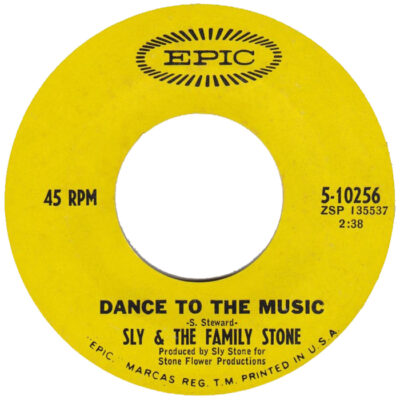 When Dance to the Music was released in 1967, it marked a turning point for Sly & the Family Stone, propelling them into mainstream success and reshaping their musical trajectory. Initially, the band had resisted the idea of crafting a more commercially viable sound, preferring the experimental approach of their debut album, A Whole New Thing. However, under pressure from Epic Records executive Clive Davis, Sly Stone embraced a new formula—one that blended psychedelic rock, gospel, and funk into an accessible, high-energy anthem.
When Dance to the Music was released in 1967, it marked a turning point for Sly & the Family Stone, propelling them into mainstream success and reshaping their musical trajectory. Initially, the band had resisted the idea of crafting a more commercially viable sound, preferring the experimental approach of their debut album, A Whole New Thing. However, under pressure from Epic Records executive Clive Davis, Sly Stone embraced a new formula—one that blended psychedelic rock, gospel, and funk into an accessible, high-energy anthem.
The success of Dance to the Music not only introduced the world to Sly’s signature style but also laid the foundation for his later work. The song’s layered instrumentation, call-and-response vocals, and vibrant horn sections became defining elements of the band’s sound. It was the first track to fully showcase the interplay between band members, with each musician contributing distinct elements that created a dynamic, celebratory atmosphere. This approach carried over into subsequent albums, including Stand! and There’s a Riot Goin’ On, where Sly continued to refine his fusion of funk and social consciousness.
Beyond its musical structure, Dance to the Music influenced Sly’s philosophy on songwriting and production. It demonstrated the power of accessibility—how a song with a simple, infectious groove could reach a wider audience while still maintaining artistic integrity. This realization shaped his later compositions, as he sought to balance commercial appeal with deeper, more introspective themes. By the early 1970s, his music took a darker, more complex turn, but the foundational elements introduced in Dance to the Music remained, evolving into the raw, stripped-down funk of There’s a Riot Goin’ On.
Ultimately, Dance to the Music was more than just a hit single—it was a blueprint for Sly’s future innovations. It proved that funk could be both joyous and revolutionary, setting the stage for his later explorations into rhythm, groove, and social commentary. Even as his sound became more introspective, the energy and communal spirit of Dance to the Music remained at the heart of his artistic vision, influencing generations of musicians who followed in his footsteps.
Core Members of Sly & the Family Stone
- Sly Stone – Lead vocals, keyboards, guitar, harmonica
- Freddie Stone – Guitar, vocals (Sly’s brother)
- Rose Stone – Keyboards, vocals (Sly’s sister)
- Larry Graham – Bass guitar, vocals (pioneered the “slap bass” technique)
- Cynthia Robinson – Trumpet, vocals (one of the first prominent female horn players in rock)
- Jerry Martini – Saxophone (brought jazz and psychedelic influences)
- Greg Errico – Drums (laid down the funky, syncopated rhythms)
How Sly Discovered His Bandmates
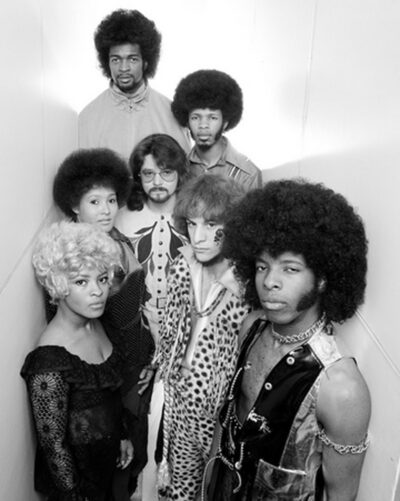 Sly Stone’s journey to assembling Sly & the Family Stone was as unconventional as his approach to music. Rather than forming a band through traditional industry channels, he built his group organically, drawing from personal connections, local talent, and a vision that transcended genre and race. His experience as a radio DJ and producer in San Francisco gave him access to a wide range of musicians, allowing him to handpick individuals who shared his passion for innovation.
Sly Stone’s journey to assembling Sly & the Family Stone was as unconventional as his approach to music. Rather than forming a band through traditional industry channels, he built his group organically, drawing from personal connections, local talent, and a vision that transcended genre and race. His experience as a radio DJ and producer in San Francisco gave him access to a wide range of musicians, allowing him to handpick individuals who shared his passion for innovation.
The first key recruit was Freddie Stone, Sly’s younger brother, a gifted guitarist and vocalist. Their sibling bond provided a strong foundation for the band’s chemistry. Sly then brought in Rose Stone, their sister, whose keyboard skills and soulful voice added depth to the group’s harmonies. The band’s rhythm section was anchored by Larry Graham, a bassist whose slap technique would revolutionize funk, and Greg Errico, a drummer with a dynamic, jazz-influenced style.
Sly’s vision extended beyond family ties. He sought musicians who could blend genres effortlessly, leading him to Cynthia Robinson, a fierce trumpeter whose commanding presence defied expectations for women in funk. Jerry Martini, a saxophonist with a background in jazz, rounded out the lineup, bringing a melodic richness to their sound. Together, these musicians formed one of the first racially integrated, mixed-gender bands in rock history—a radical statement in the late 1960s.
The chemistry between these artists was immediate. Sly encouraged a collaborative, free-flowing approach, allowing each member to contribute their unique style while maintaining a unified groove. Their diverse backgrounds—ranging from gospel and jazz to rock and soul—created a sonic fusion unlike anything heard before. This collective energy became the heartbeat of Sly & the Family Stone, propelling them to legendary status and reshaping the landscape of popular music.
Messaging “Everyday People”
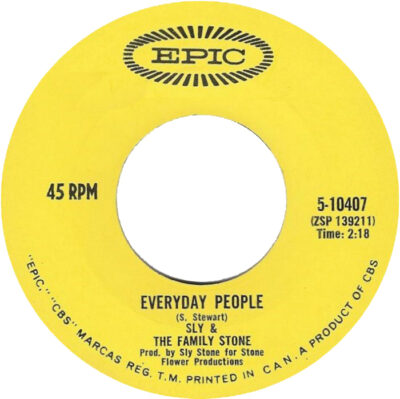 In November 1968, “Everyday People” was released during one of the most turbulent years in American history. Against the backdrop of the Vietnam War, the assassinations of Martin Luther King Jr. and Robert F. Kennedy, and widespread civil rights protests, Sly & the Family Stone delivered a song that became an anthem for unity and acceptance.
In November 1968, “Everyday People” was released during one of the most turbulent years in American history. Against the backdrop of the Vietnam War, the assassinations of Martin Luther King Jr. and Robert F. Kennedy, and widespread civil rights protests, Sly & the Family Stone delivered a song that became an anthem for unity and acceptance.
Sly & the Family Stone’s Everyday People is more than just a song—it is a timeless anthem of unity, acceptance, and social harmony. Released in November 1968, the track became the band’s first No. 1 hit, topping the Billboard Hot 100 for four consecutive weeks in early 1969. At a time of deep racial and social divisions in America, Sly Stone crafted a message that was both simple and profound: we are all the same, regardless of race, background, or status.
The lyrics of Everyday People reject prejudice and discrimination, using a conversational tone to highlight the absurdity of societal divisions. The song’s famous refrain—“I am no better and neither are you / We are the same whatever we do”—encapsulates its core philosophy. Sly’s playful yet pointed verses describe different groups refusing to accept one another, concluding with the phrase “Different strokes for different folks”, which became a cultural catchphrase. The song’s childlike cadence, reminiscent of playground taunts, reinforces the idea that hatred and exclusion are learned behaviors, not inherent truths.
Musically, Everyday People marked a departure from the band’s usual psychedelic funk sound, opting for a more mainstream, pop-friendly arrangement. The track’s gentle groove, layered harmonies, and uplifting melody made it universally accessible, ensuring its message reached a broad audience. Bassist Larry Graham’s pioneering slap bass technique, which would later define funk music, made its first appearance on this track, adding a rhythmic depth that subtly underscored the song’s urgency.
Beyond its commercial success, Everyday People became a cultural touchstone, influencing generations of artists and activists. It was performed at Woodstock 1969, further cementing its status as an anthem for peace and equality. Over the decades, the song has been covered by numerous artists, including Aretha Franklin, Joan Jett, and Pearl Jam, proving its enduring relevance.
Sly Stone’s vision for Everyday People was clear: music as a force for unity. In a world still grappling with division, the song’s message remains as powerful today as it was in 1968. It is a reminder that, despite our differences, we are all everyday people, and we must learn to live together.
“Everyday People” wasn’t just a song—it was a statement. It captured the hope for unity in a divided nation and remains one of the most powerful social anthems of the era.
On the Ed Sullivan Show: Sly Stone’s Funk Breaks Through the Screen
Sly & the Family Stone’s appearances on The Ed Sullivan Show were more than just televised performances—they were cultural milestones that brought their electrifying funk and message of unity into millions of American homes. At a time when television rarely showcased integrated bands, Sly and his group shattered expectations, delivering high-energy, genre-defying sets that left audiences in awe.
Sly & the Family Stone made their first appearance on December 29, 1968, performing a medley that included “Dance to the Music” and “Everyday People.” Dressed in vibrant, psychedelic outfits and rocking their signature Afros, the band delivered a high-octane performance that stunned viewers. Sly opened with the powerful line:
“Don’t hate the black, don’t hate the white. If you get bitten, simply hate the bite.”
Their first appearance on Sullivan’s CBS show, was a defining moment. Sly opened with a powerful statement on racial harmony, setting the tone for a performance that was as much about social change as it was about music. The band’s seamless interplay, call-and-response vocals, and dynamic stage presence turned the broadcast into a celebration of diversity and joy.
On March 23, 1969, they returned with “Love City”, a performance that broke the traditional boundaries of television. Mid-song, Sly and the band left the stage to dance among the audience, transforming the studio into a communal, funk-fueled experience. This moment was emblematic of their ethos—music as a force for unity, breaking down barriers between artist and listener.
Their performances on The Ed Sullivan Show helped propel their message and sound into the mainstream, proving that funk was more than just a genre—it was a movement. The band’s ability to blend rock, soul, and psychedelic influences while delivering socially conscious lyrics made them one of the most important acts of their time. These televised moments weren’t just showcases of musical brilliance; they were declarations of visibility, artistry, and change.
Sly & the Family Stone’s apperances on The Ed Sullivan Show remains a testament to their revolutionary impact on music and culture. Their performances were not just about entertainment—they were about transformation, proving that funk could transcend the stage and become a powerful force for unity and progress. Their presence on national television ensured that their message reached beyond concert halls, embedding itself into the fabric of American music history.
You can watch their performances here and here.
A New Decade of Hits in the 1970s
The 1970s marked both a creative peak and a turbulent turning point for Sly & the Family Stone. Coming off the euphoric highs of the late ’60s, the band entered the new decade with a string of powerful, genre-defining hits that solidified their place in music history. At the forefront was “Thank You (Falettinme Be Mice Elf Agin),” released in early 1970, a track that fused biting social commentary with a thunderous groove. Its raw energy and Larry Graham’s pioneering slap bass technique made it an instant classic, reaching No. 1 on the Billboard Hot 100 and signaling a darker, funkier evolution in the band’s sound.
That same year, “Everybody Is a Star” and “Hot Fun in the Summertime” continued to showcase the group’s versatility—balancing optimism with introspection. But it was 1971’s “Family Affair” that marked a dramatic shift. With its stripped-down production and haunting electric piano, the song reflected Sly Stone’s growing disillusionment and internal struggles. It became the band’s third No. 1 hit, resonating with a nation grappling with post-’60s uncertainty.
Other standout tracks from the era included “Runnin’ Away,” “If You Want Me to Stay,” and “Time for Livin’,” each offering glimpses into Sly’s evolving worldview—sometimes playful, sometimes weary, always innovative. These songs, while commercially successful, also hinted at the band’s unraveling. The joyful chaos that once defined their music began to give way to a more introspective, solitary sound, mirroring Sly’s retreat from the spotlight.
Despite the challenges, the 1970s cemented Sly & the Family Stone’s legacy as pioneers of funk and soul. Their hits from this era not only dominated the charts but also laid the groundwork for future genres, influencing artists from Prince to Public Enemy. The music of the ’70s may have marked the beginning of the end for the band’s original lineup, but it also ensured that their revolutionary spirit would echo through generations.
The 1970s: Key Factors in the Band’s Decline
Sly & the Family Stone’s meteoric rise in the late 1960s and early 1970s was fueled by their groundbreaking fusion of funk, rock, and soul, along with their socially conscious lyrics and electrifying performances. However, by the mid-1970s, the band’s trajectory took a downward turn, marked by internal conflicts, substance abuse, and industry pressures that ultimately led to their decline.
One of the most significant factors was Sly Stone’s increasing struggles with drug addiction. As his dependence on substances grew, his reliability as a bandleader diminished. Missed performances, erratic behavior, and studio delays became common, frustrating both his bandmates and record executives. The once-tight unit began to fracture, with key members such as bassist Larry Graham and drummer Greg Errico departing due to tensions within the group.
The shift in musical direction also played a role. While There’s a Riot Goin’ On (1971) was a critical success, its darker, more subdued tone marked a departure from the band’s earlier, more exuberant sound. The album’s murky production reflected Sly’s personal struggles, and while it resonated with audiences, subsequent releases failed to capture the same magic. The band’s later albums lacked the cohesion and innovation that had defined their earlier work, leading to a decline in commercial success.
Financial mismanagement and legal troubles further exacerbated the situation. Sly’s erratic behavior led to disputes with promoters and record labels, and his financial instability resulted in lawsuits over unpaid royalties and contractual breaches. By the late 1970s, the band had effectively disbanded, with Sly attempting sporadic comebacks that never regained the momentum of his peak years.
Despite these challenges, Sly & the Family Stone’s legacy remained intact. Their influence on funk, R&B, and hip-hop endured, with countless artists citing them as pioneers. While their decline was marked by turmoil, their contributions to music history remain undeniable, ensuring that their impact continues to be felt across generations.
The 1980s: Attempt at Revival
By the early 1980s, Sly Stone’s career had largely faded from the mainstream, overshadowed by years of personal struggles, substance abuse, and industry setbacks. However, there were attempts at revival, efforts to reclaim his place in the evolving musical landscape. The decade saw sporadic collaborations, new recordings, and fleeting performances, but none were able to restore the brilliance of his earlier years.
One of the most notable revival attempts came with the release of Ain’t But the One Way in 1982. Originally intended as a comeback album, the project was plagued by delays, creative conflicts, and Sly’s increasing unreliability. The album, produced under the supervision of Stewart Levine after Sly’s erratic behavior made self-production impossible, lacked the cohesion and innovation that had defined his earlier work. While it featured contributions from legendary musicians like Bootsy Collins, the final product was a shadow of Sly’s former genius, receiving lukewarm reviews and failing to reignite his career.
Throughout the decade, Sly made sporadic appearances, including collaborations with artists such as George Clinton and Bobby Womack. His influence on funk and R&B remained undeniable, but his ability to actively participate in the industry was hindered by his ongoing struggles. Attempts to tour were inconsistent, with missed shows and unpredictable performances becoming the norm. By the late 1980s, Sly had largely retreated from public life, making only rare appearances and living in relative obscurity.
Despite the failed revival, Sly Stone’s legacy left his imprint in the music world. His pioneering work in funk, soul, and rock continued to inspire generations of musicians, and his influence could be heard in the emerging sounds of hip-hop and modern R&B. While the 1980s did not bring the triumphant return many had hoped for, Sly’s impact on music remained undeniable, ensuring that his contributions would never be forgotten.
Sly Stone received numerous accolades throughout his career, recognizing his groundbreaking contributions to music. Here are some of the most significant industry honors he received:
Major Awards & Recognitions
- Rock & Roll Hall of Fame Induction (1993) – Sly & the Family Stone were inducted, cementing their place in music history.
- Grammy Lifetime Achievement Award (2017) – Honored for his pioneering influence on funk, soul, and rock.
- Woodstock Legacy Recognition – His electrifying 1969 performance remains one of the most celebrated moments in festival history.
- BET Lifetime Achievement Award (2006) – Recognized for his impact on Black music and culture.
- RIAA Multi-Platinum Certifications – Albums like Stand! and There’s a Riot Goin’ On sold millions of copies, earning platinum status.
- Hulu Documentary Tribute (2025) – Sly Lives! (aka The Burden of Black Genius), directed by Questlove, honored his legacy and influence.
Even beyond official awards, Sly’s impact on music is immeasurable—his innovations shaped funk, R&B, hip-hop, and rock, influencing generations of artists. His genre-blending sound, socially conscious lyrics, and electrifying performances remain legendary.
A Marked Legacy in Life
 In his final years, Sly Stone remained a towering figure in music, even as he battled personal and health challenges. The funk pioneer, who had revolutionized popular music with his genre-blending sound and socially conscious lyrics, spent much of his later life away from the public eye. His struggles with substance abuse, financial instability, and chronic health issues, particularly COPD, made his last decades difficult. Despite these hardships, his influence never waned.
In his final years, Sly Stone remained a towering figure in music, even as he battled personal and health challenges. The funk pioneer, who had revolutionized popular music with his genre-blending sound and socially conscious lyrics, spent much of his later life away from the public eye. His struggles with substance abuse, financial instability, and chronic health issues, particularly COPD, made his last decades difficult. Despite these hardships, his influence never waned.
Sly’s legacy was cemented not only through his groundbreaking work with Sly & the Family Stone but also through the generations of artists he inspired. His music continued to resonate, shaping the sounds of funk, R&B, hip-hop, and rock. Even as he withdrew from the industry, his impact remained undeniable. In 2023, he released his memoir, Thank You (Falettinme Be Mice Elf Agin), offering a candid reflection on his life, career, and struggles. The book provided insight into his creative genius and the challenges that accompanied his rise to fame.
In his final years, Sly completed a screenplay about his life, a project his family has expressed eagerness to share with the world. His passing on June 9, 2025, at the age of 82, marked the end of an era, but his music and message continue to inspire. Tributes poured in from fans and fellow musicians, celebrating his contributions to music and culture. His legacy lives on in the countless artists who have drawn from his innovations, ensuring that his influence will endure for generations to come.
How We Should Remember Sly Stone
Sly Stone was not just an artist—he was a visionary, a rebel, and a musical prophet. His sound broke racial and genre barriers, his lyrics spoke to generations, and his legacy will never fade.
He left us seven days ago. As we reflect on his life, we must remember him as the architect of funk, the voice of unity, and the soundtrack to change. His songs will never stop playing, and his influence will never stop growing.
Rest in power, Sly Stone—your groove lives on.
__________________
A USARM Viewing Tip: On your mobile or tablet device? Finger-tap all the above images inside the post and stretch image across your device’s screen for LARGEST digitized view.


